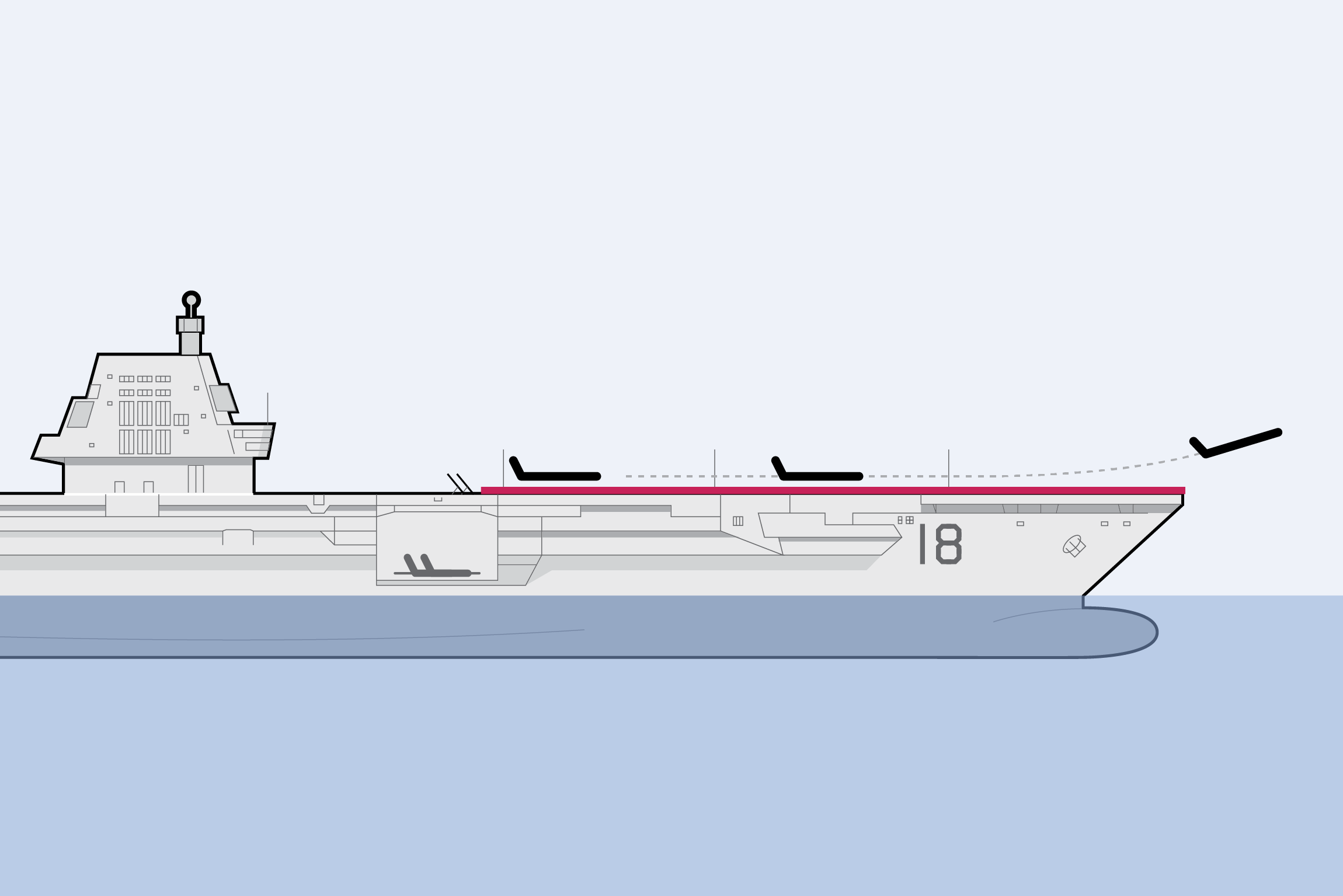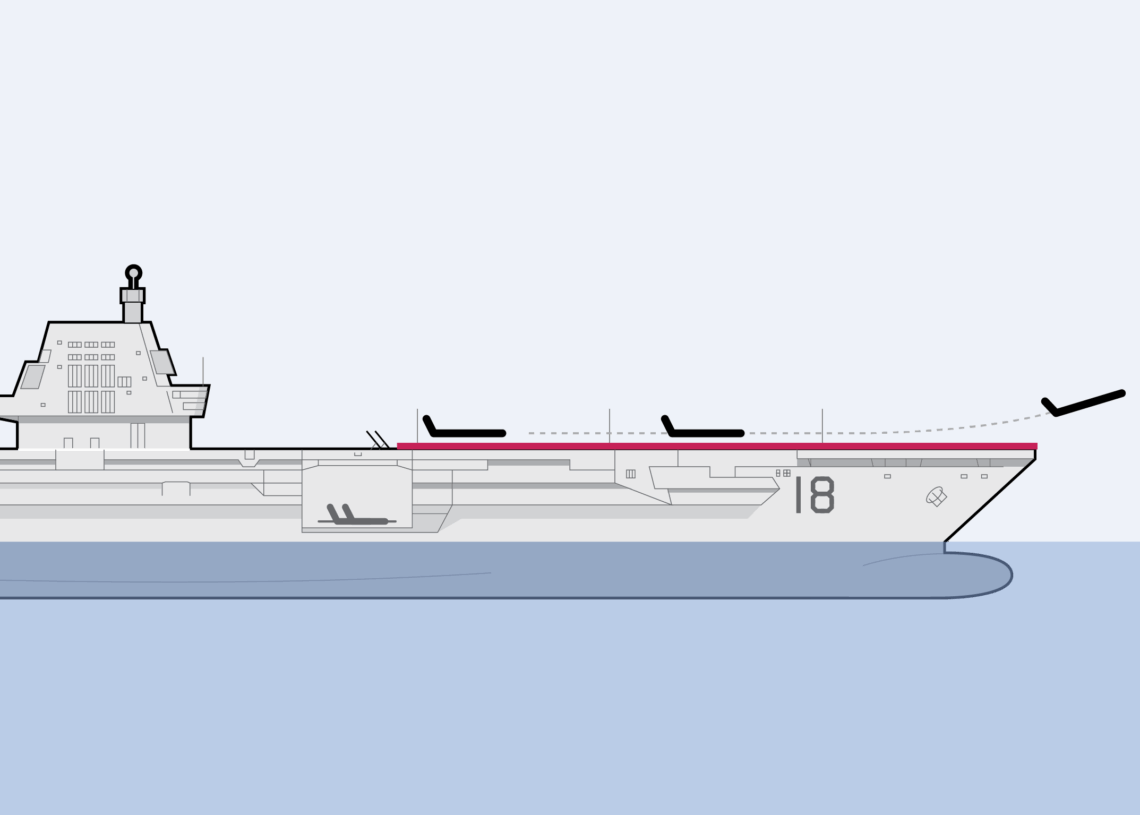
China’s efforts to blunt American maritime power in the Pacific, a region the United States has long considered its domain, received a major boost this month with the official launch of its third — and most advanced by far — aircraft carrier, the Fujian.
The 80,000-ton supercarrier, which can accommodate about 60 aircraft and will be accompanied by as many as 10 warships, will dramatically narrow the naval capability gap between the U.S. and China, according to American, Japanese, Taiwanese and Chinese analysts. It will also enable Beijing to further intimidate rivals in the South China Sea and Taiwan Strait.
China’s efforts to blunt American maritime power in the Pacific, a region the United States has long considered its domain, received a major boost this month with the official launch of its third — and most advanced by far — aircraft carrier, the Fujian.
The 80,000-ton supercarrier, which can accommodate about 60 aircraft and will be accompanied by as many as 10 warships, will dramatically narrow the naval capability gap between the U.S. and China, according to American, Japanese, Taiwanese and Chinese analysts. It will also enable Beijing to further intimidate rivals in the South China Sea and Taiwan Strait.
“We’re really entering a new era here,” said Lyle Goldstein, an associate professor at the Naval War College.
China was already a significant adversary: It has the world’s largest navy by number of ships, biggest arsenal of ground-launched ballistic and cruise missiles, and largest active military service, with a standing army of 2 million soldiers.
But China has lagged the United States in aircraft carrier technology.
Now, the launch of the Fujian will bring Beijing closer to its goal of eroding U.S. maritime primacy in its backyard, not least because the warship uses electromagnetic catapults to launch planes, making China the only the country, after United States, to have developed and built this technology.
“It’s not a small jump,” Goldstein said of the Fujian’s catapults. “It’s literally doubling or tripling — maybe even quadrupling — the combat lethality.”
The supercarrier is critically important to China’s Xi Jinping, the country’s strongest leader in decades and one who wants a world-class military with capabilities to match the U.S. by 2049.
Underscoring how central the Fujian is to this goal, state broadcaster CCTV last week reported that Xi “personally” made the decision to adopt electromagnetic catapult technology. During the launch ceremony on the southern military stronghold of Hainan, Xi — dressed in a green military shirt — pressed the catapult button and sent the launch shuttle forward “like an arrow leaving the string of a bow,” CCTV said.
The carrier fulfills multiple goals for Chinese military strategy: Its strike group — comprising fighter jets, stealth fighters, surveillance planes and cruisers laden with anti-ship missiles — will bolster Beijing’s intimidation of rival claimants in the disputed waterways of the South China Sea.
The Fujian will also add heft to China’s threats to blockade Taiwan, the self-governing island Beijing claims as its territory. And it will extend the Chinese military’s reach far into the Pacific.
The U.S. retains a clear military edge: It has 11 operational aircraft carriers, and all are nuclear-powered and larger than China’s. The Fujian is powered by conventional fuel.
But the U.S. projects its power around the world, while Beijing can concentrate on Asia. That makes the military balance in the region look far more precarious than before, said Toshi Yoshihara, a senior fellow at the Center for Strategic and Budgetary Assessments, a Washington-based think tank.
The speed of Chinese progress has been dramatic.
When China commissioned its first aircraft carrier, the Liaoning, in 2012, it was widely dismissed as an outdated Soviet design retrofitted from a secondhand hull. Its next attempt, the Shandong, in 2019, was built in China but based on the Liaoning.
Now, Beijing has unveiled a domestically designed supercarrier with electromagnetic catapults. This launch system uses rapidly moving magnetic fields to accelerate aircraft along a track and fling them into the sky, enabling the Chinese military to launch heavier planes and at a far faster rate than before.
Only one U.S. carrier, the USS Gerald R. Ford, which was commissioned in 2017, uses this technology. But concerns about the reliability of its systems have led President Donald Trump to suggest that future carriers should return to steam-powered catapults.
China, however, claims to have mastered the electromagnetic catapult. State media in September broadcast footage of fighter jets and surveillance planes being launched from and landing back on the Fujian’s flight deck during sea trials.
Chinese military experts claim that the three catapults of the Fujian can launch as many as 300 aircraft a day, on par with the most advanced U.S. carrier — although that may be an exaggeration.
The layout of the Fujian’s flight deck makes it difficult to launch and land aircraft simultaneously, military analysts say. Still, its launch rate will be far higher than China’s two older carriers.
Even allowing for the hyperbole of Chinese propaganda, the Fujian is shaping up to be a “completely different beast” from its predecessors, said Joaquin Camarena, a former U.S. Marine Corps intelligence officer who tracks China’s military modernization.
China’s carrier program is focused on mastering revolutionary technologies that can modernize the country’s entire navy, said Tian Shichen, a retired People’s Liberation Army (PLA) Navy captain.
“It’s like the Apollo program,” said Tian, who is now president of the Global Governance Institution, a Beijing-based think tank. “Its value wasn’t the footprint on the moon but the overall technological leap required to make it possible.”
The Fujian has a significantly enhanced ability to detect enemy targets and act as a floating command center and air base. This will help deny adversaries access to the seas and skies in a potential conflict in the South China Sea or over Taiwan.
The carrier’s catapults make it the only ship in the Chinese navy capable of launching the KJ-600 early-warning aircraft, dubbed the PLA Navy’s “brain in the sky” by local media.
This plane, China’s answer to the U.S. E-2 Hawkeye, made its debut during a grand military parade in Beijing in September. Its extended radar range — at least double that of the helicopters used on China’s older carriers — enables the KJ-600 to look over the horizon, gather real-time information and relay commands, boosting the carrier’s ability to conduct complex defensive operations and offensive strikes far out at sea.
“They have bridged that gap with the U.S., at least in theory,” said Collin Koh, an expert on the Chinese military at the S. Rajaratnam School of International Studies in Singapore. “That certainly expands the PLA Navy’s far-seas combat capability.”
The Fujian will be a force amplifier that brings together several advances in Chinese air and maritime combat power.
Its strike group is expected to include Type 055 stealth guided-missile cruisers armed with an array of ballistic missiles designed to overpower the air defenses of U.S. naval vessels. It is nicknamed the “carrier killer” in Chinese state media and is thought to carry the latest YJ-21 hypersonic anti-ship missiles.
One of the most formidable warships afloat, it was “built for the purpose of protecting carriers,” said Goldstein.
The air wing will include upgraded J-15 fighter jets with inbuilt, electronic-warfare capabilities and next-generation J-35 stealth fighters.
A single aircraft carrier cannot upend the regional security balance, said Li Da-jung, an expert on the Chinese military at Tamkang University in Taiwan, but the Fujian is a milestone that cannot be ignored. “If I were the U.S.,” he said, “I would treat this with great seriousness.”
Countering American carrier dominance in the Asia-Pacific region has been an obsession for Beijing ever since the 1990s, when a crisis over Taiwan led the U.S. to send multiple aircraft carriers through the Taiwan Strait — infuriating Beijing over what it deemed an “internal” affair.
That display became a “major catalyst for China’s naval modernization,” said Edward Sing Yue Chan, a postdoctoral fellow at Australian National University. It led Beijing to see carrier capabilities as “essential for any country aspiring to great-power status,” he said.
Decades later, Beijing has hailed the arrival of the Fujian as evidence it can effectively challenge U.S. naval dominance across critical maritime domains in the Pacific.
The U.S. had relied on geographical lines to contain China during the Cold War — mainly the first and second island chains, which run south from Japan, forming maritime chokepoints to access the Pacific Ocean.
“China wants to push U.S. forces out from inside the first island chain and then be able to operate freely within the second island chain,” said Moriki Aita, a research fellow at National Institute for Defense Studies, a Tokyo-based think tank under Japan’s Defense Ministry.
In May and June, China’s two older carriers held simultaneous drills in the Western Pacific near Japan’s outlying islands, with their associated aircraft conducting over 1,100 sorties, in a display of Beijing’s growing confidence.
Chinese state media has hailed the Fujian’s even greater ability to operate near the second island chain as a way to deter Taiwan from moving toward formal independence.
Beijing has long used its military to intimidate Taiwan but has contained its activity to the island’s east coast, just 100 miles from China. In recent years, it has increasingly been encircling Taiwan in an effort to test the island’s defenses.
Taiwanese defense experts fear that campaign will only intensify with the Fujian.
“We once assumed the east coast was relatively safe,” Ding Shuh-fan, an expert on the Chinese military at National Chengchi University in Taipei. “Now,” Ding said, “every corner of Taiwan is threatened.”
Xi has made China’s “unification” with Taiwan a top priority — even though the Chinese Communist Party has never ruled the island. Some U.S. officials — including former CIA director William J. Burns and the former Indo-Pacific commander, retired Navy admiral Philip Davidson — have said he wants the Chinese military to be prepared to invade by 2027, if he deems force necessary.
Any Chinese invasion is unlikely to be led by an aircraft carrier strike group, analysts say — it would probably rely on rocket bombardment, and amphibious and airborne assaults.
But carrier strike groups could be an important component of China’s other critical objective: Keeping the U.S. and its allies from coming to Taiwan’s aid.
In an escalating conflict, China would probably send carriers and destroyers out past the first island chain in a bid to “delay, disrupt and degrade U.S. capabilities,” said J. Michael Dahm, a retired U.S. Navy intelligence officer now at George Washington University.
The Fujian has only just been commissioned, but China might be working on its next aircraft carrier. Construction is underway at a dry dock in China’s northeast on a huge ship that some analysts believe will become a fourth carrier.
Whether or not the vessel becomes a next-generation supercarrier, there is little doubt that Beijing wants its next iteration to be even bigger than the Fujian — and to rely on nuclear propulsion, like American carriers. U.S. warships use pressurized water reactors to travel long distances and operate power-hungry catapults and radars for decades without needing to refuel.
Developing these reactors has eluded Beijing. But in late 2024, analysts at the Middlebury Institute of International Studies in California concluded, based on satellite images, that China had built a prototype of the kind of reactor needed to power large warships in the southwestern province of Sichuan.
Another sign of progress on a fourth, even larger carrier: Satellite imagery shows that a concrete carrier mock-up in Wuhan, used for testing radar systems and practicing aircraft maneuvers, was significantly enlarged this year.
The PLA Navy wants to match the U.S. Navy’s carrier capabilities within a decade. Already, Dahm said, they’re “ahead of where they need to be.”
Data from U.S. and Taiwanese military analysts, Chinese state media reports, the Japan Joint Staff Office and the U.S. Defense Department.
Rudy Lu in Taipei, Taiwan, and Chie Tanaka in Tokyo contributed to this report. Editing by Anna Fifield, Adrián Blanco Ramos, Joseph Moore, Natalia Jiménez and Luis Velarde. Copy editing by Melissa Ngo.
The post China’s new aircraft supercarrier challenges U.S. dominance in Pacific
appeared first on Washington Post.




